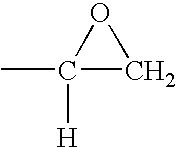Brominated and epoxidized flame retardants
a technology applied in the field of brominated and epoxidized compounds, can solve the problems of limiting their bioavailability, material not expected to bioaccumulate, gel formation, etc., and achieves the effects of good flame retardant performance, excellent thermal stability, and good oxidation resistan
- Summary
- Abstract
- Description
- Claims
- Application Information
AI Technical Summary
Benefits of technology
Problems solved by technology
Method used
Image
Examples
example 1
[0071]A styrene-butadiene-styrene triblock copolymer containing 46% polymerized styrene and 54% polymerized butadiene is brominated and then epoxidized. Approximately 84% of the butadiene units in the starting triblock copolymer are 1,2-butadiene units; the remainder are mainly 1,4-butadiene units. 5.8 g of this copolymer are dissolved in 30 mL of 1,2-dichloroethane. A separate solution of tetraethylammonium tribromide is prepared by dissolving 7.2 g of bromine and 11.2 g of tetraethylammonium monobromide salt into 30 mL of 1,2-dichloroethane. The solutions are mixed together at room temperature for about an hour, and then left to stand undisturbed for about 2 days. Tetraethylammonium monobromide precipitates as the reaction proceeds. At the end of the reaction, the precipitate is filtered off, and the filtrate is rinsed with an additional 40 mL of 1,2-dichloroethane. The organic layer is then washed with 60 grams of a 1% aqueous sodium bisulfite solution and 60 grams of a 0.6% aque...
example 2
[0073]Example 1 is repeated, changing the reaction times slightly so that 80% of the starting butadiene units are brominated, 18% are epoxidized and about 2% remain unreacted. The epoxidation is essentially all of the terminal type. The 5% WLT for the brominated and epoxidized material is 254° C. About 1.8% of the bromine is bound to allylic or tertiary carbon atoms. The polymer contains about 54% bromine by weight.
example 3
[0074]Example 1 is repeated again, changing the reaction times slightly so that 88% of the starting butadiene units are brominated, 7% are epoxidized and about 5% remain unreacted. The epoxidation is essentially all of the terminal type. The 5% WLT for the brominated and epoxidized material is 255° C. About 0.3% of the bromine is bound to allylic or tertiary carbon atoms. The polymer contains about 57% bromine by weight.
PUM
| Property | Measurement | Unit |
|---|---|---|
| weight percent | aaaaa | aaaaa |
| weight percent | aaaaa | aaaaa |
| temperatures | aaaaa | aaaaa |
Abstract
Description
Claims
Application Information
 Login to View More
Login to View More - R&D
- Intellectual Property
- Life Sciences
- Materials
- Tech Scout
- Unparalleled Data Quality
- Higher Quality Content
- 60% Fewer Hallucinations
Browse by: Latest US Patents, China's latest patents, Technical Efficacy Thesaurus, Application Domain, Technology Topic, Popular Technical Reports.
© 2025 PatSnap. All rights reserved.Legal|Privacy policy|Modern Slavery Act Transparency Statement|Sitemap|About US| Contact US: help@patsnap.com



